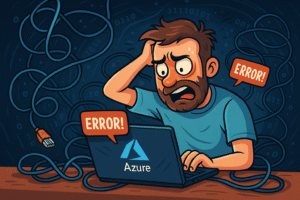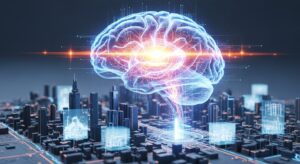Taming the Enterprise ‘Spaghetti’: How AI is Revolutionizing System Complexity Management for Architects and CTOs
Imagine it’s 2025, and instead of wrestling with outdated architecture diagrams drawn months ago, your AI co-pilot has already presented a living, breathing map of your entire enterprise IT landscape, highlighting redundancies and inefficiencies while you sip your morning coffee. For enterprise architects, IT portfolio managers, and CTOs, this isn’t a futuristic fantasy; it’s the imminent reality powered by advanced Artificial Intelligence.
In today’s sprawling digital enterprises, the sheer volume of applications, databases, and intertwined processes can feel less like a well-orchestrated symphony and more like an unruly plate of spaghetti. Understanding the intricate relationships between hundreds, even thousands, of systems is a Herculean task for any human team. When asked how many systems perform a specific function, or what the true impact of decommissioning a legacy application might be, many enterprises simply shrug, lacking precise answers. This “shrug factor” represents not just a knowledge gap, but a significant impediment to agility, efficiency, and innovation.
For years, the manual mapping of enterprise systems has been a slow, painstaking, and often outdated exercise. But what if there was a way to crunch the data no single human could ever process, revealing hidden insights that lead to dramatic simplification and substantial cost reduction? This is where AI steps onto the stage, not as a replacement for human ingenuity, but as a powerful magnifier of our capabilities. This article will explore how AI is fundamentally changing how we manage and optimize complex enterprise systems, moving beyond the guesswork to provide precise, data-driven answers. We’ll delve into how AI-driven tools empower leaders like you to gain unprecedented visibility, identify and eliminate waste, and accelerate your organization’s journey towards a leaner, more coherent, and more resilient IT landscape. Prepare to discover how AI can be your enterprise MRI scan, showing you where the clots and blockages are in the flow of information, helping you to make more informed decisions, faster.
AI-Driven Discovery and Mapping: Unveiling the Hidden Landscape
The first, and perhaps most foundational, challenge in managing enterprise complexity is simply knowing what you have and how it all connects. Many organizations operate with a fragmented understanding of their IT ecosystem, often relying on outdated documentation or the tribal knowledge of long-tenured employees. It’s like trying to navigate a sprawling city without a current map – you know the major landmarks, but the intricate web of alleys and back roads remains a mystery, leading to inefficiencies, security vulnerabilities, and stalled innovation. This is where AI-driven discovery and mapping tools revolutionize the game.
Traditional methods of application dependency mapping (ADM) often involve painstaking manual interviews, analyzing network traffic logs, configuration files, and even sifting through legacy codebases. It’s a process that is not only excruciatingly time-consuming but also inherently prone to error and quickly obsolete as systems evolve. In a rapidly changing digital landscape, a static map is no map at all; it’s a historical artifact. Enter AI, armed with advanced algorithms capable of ingesting and correlating vast quantities of operational data – from real-time network traffic and server logs to API calls, database queries, code repositories, and even cloud service configurations. These intelligent systems don’t just collect data; they analyze it to automatically discover, categorize, and map the relationships between every application, service, data flow, and infrastructure component within your enterprise.
Imagine an AI system continuously scanning your network traffic, identifying every data packet, every inter-application communication, and every user interaction. It’s not just detecting anomalies; it’s building a comprehensive, living application dependency map and an asset inventory in real-time. It can pinpoint exactly which applications communicate with each other, what data is exchanged, and even infer the underlying business processes they support. For an enterprise architect, this means a paradigm shift: moving from static, brittle diagrams that quickly become irrelevant to a dynamic, always-up-to-date visual representation of their entire IT estate. Consider a hypothetical example: a large financial institution that has grown through decades of mergers and acquisitions, resulting in an estimated “hundreds” of disparate data flows and applications. An AI-powered discovery tool might precisely identify not just 1,200 unique data flows, but also their sources, destinations, and transformation points, automatically clustering them into five core business capabilities, such as “Customer Onboarding,” “Transaction Processing,” or “Regulatory Reporting.” This immediate clarity transforms an overwhelming mess into actionable intelligence, providing a clear pathway for consolidation or optimization initiatives.
This capability is particularly vital for IT portfolio managers who need a precise, verifiable inventory of all assets to make informed investment and divestment decisions. Knowing exactly which applications are active, who uses them, what dependencies they have, and their associated costs allows for strategic planning that minimizes disruption and maximizes business value. Without AI, manually building such an inventory for an enterprise with thousands of servers, hundreds of applications, and a complex microservices architecture is a multi-year project, often outdated before it’s even complete, akin to trying to count grains of sand on a constantly shifting beach. AI provides the objective, granular data that helps answer questions like, “Do we really need three different CRM systems?” or “Which applications will be impacted if we migrate this database?” with high confidence.
Moreover, AI’s discovery extends beyond just applications and data flows. It can map cloud resource usage, identifying orphaned instances or underutilized services that are still incurring costs. It can analyze network topology and identify shadow IT, bringing undocumented systems into the fold. This comprehensive visibility is the cornerstone of any effective digital transformation strategy.
However, the path isn’t entirely without its bumps. The effectiveness of AI discovery tools heavily relies on the quality, completeness, and accessibility of the data they feed on. “Garbage in, garbage out” applies here, and ensuring clean, consistent data streams is a prerequisite. Data privacy concerns are paramount, as these tools often require deep access to sensitive system interactions and potentially PII. Organizations must carefully consider robust data governance frameworks, anonymization strategies, and strict access controls to ensure compliance with regulations like GDPR or CCPA and to build trust in these new capabilities. Furthermore, the sheer scale and dynamic nature of enterprise data mean that careful AI model tuning and continuous learning are required to sift through noise, adapt to changes, and accurately identify meaningful connections. Despite these challenges, the ability of AI to provide an unprecedented, real-time “MRI scan” of the enterprise, revealing every hidden connection and data pathway, makes it an indispensable asset for navigating the complexities of modern IT. It empowers human architects to spend less time on laborious manual mapping and more time on high-value strategic design, innovation, and risk mitigation, shifting their role from data gatherers to visionary strategists.
AI for Advanced Analysis and Insight: Decoding Inefficiencies
Once AI has successfully mapped the intricate web of your enterprise systems, its true analytical power comes to the forefront: identifying the ‘clots’ and ‘blockages’ within your information flow. Simply having a comprehensive map is one thing; understanding where the inefficiencies, redundancies, and suboptimal patterns lie is another entirely. This is where AI transitions from a passive cartographer to a proactive diagnostic expert, delving deep into the operational data to expose hidden problems that no human team, no matter how dedicated, could easily spot.
Think of it like this: your enterprise has accumulated layers of technological debt, much like a well-used kitchen that has acquired multiple gadgets designed for the same task over the years. You might have three different types of coffee makers, two blenders, and a juicer that largely duplicates the blender’s function. In an enterprise, this translates to multiple applications performing the same or very similar functions, data being redundantly transformed across several systems, or convoluted processes that add unnecessary steps, latency, and costs. AI, leveraging sophisticated analytical techniques such as graph analysis, pattern recognition, machine learning, and anomaly detection, excels at finding these hidden inefficiencies that are often masked by the sheer volume and complexity of interactions.
For example, an AI system might analyze data lineage across your enterprise and flag a scenario where a particular customer dataset is transformed five different times across five distinct systems – from the CRM to the data warehouse, then to a reporting tool, then to a marketing automation platform, and finally to an analytics dashboard – before reaching its final destination. This is a clear indicator of inefficiency; each transformation adds computational overhead, introduces potential for data inconsistencies or errors, and creates delays in critical business processes. The AI doesn’t just show the transformations; it highlights the redundancy, perhaps even quantifying the wasted compute cycles or the latency introduced by these unnecessary hops. Or, consider an enterprise architect wrestling with application rationalization in a company that has grown through organic expansion and numerous acquisitions: an AI could scan usage patterns, feature sets, licensing costs, and even internal code repositories to identify that two different business units are utilizing entirely separate software solutions for the exact same core business function, such as expense reporting, project management, or customer relationship management. The AI doesn’t just list them; it highlights the functional overlap, the cost implications of dual licensing, and the potential for a unified, more efficient solution. This is a powerful insight that often escapes manual audits, which are too broad and time-consuming to capture such granular, yet widespread, inefficiencies.
These advanced analytical capabilities are invaluable for IT portfolio managers who are constantly seeking ways to optimize their investments and maximize ROI. By pinpointing areas of redundant spending – whether on licenses, infrastructure, maintenance for overlapping tools, or excessive cloud resources – AI provides the irrefutable, data-driven evidence needed to justify consolidation efforts, negotiate better vendor contracts, and reallocate resources to more strategic, innovative initiatives. Furthermore, for CTOs and operations leaders, AI’s ability to identify suboptimal patterns extends beyond just cost; it encompasses performance bottlenecks, security vulnerabilities, and reliability risks. By analyzing system interactions, historical performance data (like CPU utilization, memory consumption, network latency), and incident logs, AI can predict potential failures or pinpoint integration points that are consistently causing delays or errors, enabling proactive intervention before they impact critical business operations. This predictive capability is a hallmark of modern AIOps platforms, turning reactive incident management into proactive problem prevention.
While the insights provided by AI are transformative, a critical challenge lies in validating and trusting the AI’s recommendations. Enterprise architects and IT managers, with years of invaluable experience and deep contextual knowledge of their organization’s unique quirks and historical baggage, often have an intuitive sense of where problems might lie. However, AI’s conclusions, derived from massive datasets and complex algorithms, might sometimes contradict conventional wisdom or uncover issues in unexpected, counter-intuitive places. Therefore, human oversight, critical validation, and collaborative refinement remain absolutely crucial. The AI presents the evidence and highlights the “hot spots”; the human expert applies their contextual knowledge, business understanding, and strategic vision to interpret the findings, assess feasibility, and make the final, informed decision. The analogy of an “AI enterprise MRI scan” is fitting here – the scan shows you where the clots and blockages are, but it’s the human doctor who interprets the images, diagnoses the underlying problem, considers the patient’s overall health, and prescribes the optimal treatment plan. AI empowers architects with an unparalleled depth of insight, saving countless hours previously spent on manual data collation and analysis, allowing them to focus on the higher-value task of strategic design, innovation, and guiding the business toward a more efficient future. It’s about augmenting human intelligence, not replacing it.
AI for Optimization and Strategic Planning: Architecting a Leaner Future
The ultimate goal of understanding enterprise complexity is not just to map it or identify its flaws, but to actively simplify and optimize it. This is where AI transitions from a diagnostic expert to a strategic advisor, moving beyond identifying problems to actively proposing solutions and enabling proactive architectural evolution. For enterprise architects, IT portfolio managers, and CTOs, this represents a profound shift: from reactive problem-solving and endless firefighting to proactive, intelligent system evolution and long-term strategic planning.
AI’s ability to analyze vast, disparate datasets allows it to simulate outcomes, evaluate potential impacts, and propose optimization recommendations that are both technically feasible and strategically aligned with business objectives. These recommendations can span a wide spectrum, from granular infrastructure adjustments to sweeping application consolidations and business process re-engineering. For instance, an AI might analyze cloud usage patterns across hundreds of virtual machines, storage buckets, and serverless functions, identifying not just underutilized resources but also optimal instance types, auto-scaling configurations, and potential reserved instance purchases. It can then recommend specific instances for decommissioning, rightsizing, or migration to achieve significant cost savings – a direct appeal to the bottom line for any CTO or IT portfolio manager. This moves beyond simple monitoring; it’s prescriptive optimization, driven by continuous learning from real-world usage patterns.
Consider the “spaghetti” of redundant tools previously identified by AI. Based on its deep analysis of feature sets, usage patterns, interdependencies, and even vendor roadmaps, an AI tool could propose a specific, data-backed consolidation strategy: “You have two tools doing the same job in different departments (e.g., Jira and Trello for project management); consolidate them onto Jira, which has broader integration capabilities, better scalability, and lower total cost of ownership at your current scale.” This isn’t just an observation; it’s an actionable recommendation, complete with the evidence required to justify the change to stakeholders. Furthermore, in the realm of business process optimization, AI can analyze workflows, identify bottlenecks, and suggest streamlined sequences of operations, potentially even recommending the automation of certain steps or the re-routing of data flows to minimize latency. For example, an AI could identify that a new customer onboarding process requires data to be manually extracted and re-entered into three different systems, suggesting that one central system for data ingestion and automated propagation would save 20 hours per week of manual effort, reduce errors, and accelerate time-to-value for new customers.
While AI provides these powerful recommendations, it’s crucial to remember that the human element remains firmly at the helm. Enterprise architects and IT leaders leverage these AI insights to inform their strategic decisions. The AI might suggest decommissioning an underused server or moving a workload to a more cost-effective cloud region, but it’s the human architect who evaluates the broader implications, considers any political or organizational hurdles, assesses risk profiles, and ultimately decides which system to consolidate, which process to re-engineer, or which new technology to adopt. AI becomes a force multiplier, enabling architects to make evidence-based decisions with a speed, accuracy, and depth of analysis previously impossible. It shifts their focus from tactical firefighting to strategic planning, allowing them to be true visionaries for the enterprise.
Several cutting-edge tools are emerging in the Application Portfolio Management (APM), IT Financial Management (ITFM), and AIOps spaces that embody these predictive and prescriptive capabilities. Solutions from vendors leveraging machine learning for application discovery, dependency mapping, cost optimization, and even predictive analytics for resource provisioning are becoming more prevalent. These tools often integrate seamlessly with existing IT Service Management (ITSM), Configuration Management Database (CMDB), and cloud management platforms, enriching the data landscape and providing a unified, intelligent view for proactive management. However, the inherent complexity and dynamic nature of large enterprise environments mean that simply deploying these tools isn’t a magic bullet. Careful AI model tuning, ongoing data validation, continuous learning, and a clear understanding of the AI’s limitations are essential for sustainable success. The trust in AI recommendations will only grow as the AI demonstrates its accuracy, reliability, and tangible positive impact on business outcomes over time, often requiring a phased implementation approach and iterative refinement.
The power of AI in optimization and planning is its ability to move beyond static analysis to dynamic, intelligent recommendations that drive tangible business outcomes. It transforms the daunting task of managing enterprise complexity into a strategic advantage, allowing organizations to operate more efficiently, reduce costs, enhance security postures, and respond with greater agility to market demands and competitive pressures. It’s about architecting a future where the IT landscape is a strategic enabler, not a complex impediment.
Conclusion: Architecting the Future with AI
The journey through the intricate world of enterprise systems, once a labyrinth of manual mapping and educated guesswork, is being fundamentally reshaped by the transformative power of Artificial Intelligence. We’ve explored how AI serves as an invaluable ally for enterprise architects, IT portfolio managers, and CTOs, providing a holistic approach to managing complexity: from automatically discovering and mapping the sprawling digital landscape, to precisely analyzing inefficiencies and hidden redundancies, and finally, to offering actionable, data-driven recommendations for optimization and strategic planning.
The benefits are clear and compelling: unprecedented visibility into your IT estate, enabling a “living architecture diagram” that reflects reality rather than aspiration; significant cost savings achieved by eliminating waste and optimizing resource utilization; and dramatically faster impact analysis, empowering agile decision-making in an ever-changing environment. AI’s ability to crunch data at a scale no human can, revealing insights that lead directly to simplification and cost reduction, is directly appealing to every leader striving for a leaner, more coherent IT landscape. It saves invaluable time previously spent on laborious manual mapping exercises, freeing up highly skilled professionals to focus on innovation and strategic initiatives.
However, the path to AI-powered enterprise optimization is not without its considerations. Challenges such as ensuring data privacy, building trust in AI recommendations, and the sheer scale requiring careful AI model tuning must be thoughtfully addressed. Yet, these are surmountable hurdles when weighed against the profound advantages AI offers.
The future of enterprise architecture isn’t about AI replacing human expertise, but about AI empowering it. By providing an “enterprise MRI scan,” AI equips human architects with the precise evidence needed to make informed, impactful decisions. It moves us beyond the “dial-up modem in a 5G world” of outdated practices into an era where IT systems can truly support, rather than hinder, business agility.
So, where do you begin? We strongly recommend starting an “AI audit” of a specific segment of your enterprise systems. Identify a challenging area – perhaps a legacy system ripe for modernization, or a business unit known for its siloed applications. Leverage AI-driven discovery tools to uncover low-hanging fruit for optimization, whether it’s consolidating redundant software, streamlining data flows, or rightsizing cloud resources. The insights gained from such an audit can serve as a powerful proof of concept, demonstrating how AI can uncover hidden savings and accelerate your journey towards a more agile, cost-effective, and strategically aligned IT infrastructure. The time to tame the enterprise spaghetti is now, and AI is your most powerful fork.





